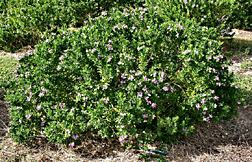A Colorful New Subtropical for U.S. Gardens
|
|
While hiking the outskirts of the Bokkeveld Mountains of South Africa during a sabbatical in 1997, university professor Alan Meerow first encountered Polygala myrtifolia, the showy evergreen shrub known as “cape milkwort.” Even then he could envision its vibrant flowers blooming year-round in subtropical U.S. ornamental gardens.
Now a plant geneticist at the Subtropical Horticulture Research Station (SHRS) in Miami, Florida, Meerow has since made followup trips to South Africa to further study this and other plants. The station was originally located in Miami for the express purpose of introducing new tropical plants into the United States. With formation of the National Plant Germplasm System (NPGS) in 1980, the SHRS mission shifted from plant introduction to conservation and genetic characterization of valuable plant stocks, or germplasm. It’s now one of 17 NPGS repositories operated by ARS nationwide.
Meerow has worked closely with ARS horticulturalist Tomas Ayala-Silva to add P. myrtifolia to the NPGS collection and develop it for distribution to commercial growers. Seed of the species was purchased from a commercial seed company in South Africa licensed to collect native plants. After 2 years of trial and evaluation, they selected one seedling with superior attributes. They named this particular variety Chapman Field to acknowledge the work done at SHRS, which is located on what used to be the U.S. Air Force’s Chapman airfield.
P. myrtifolia has small clusters of inch-long blossoms at the ends of short branches. Lower buds open first, to reveal showy purple petals beautifully marked with darker veins. It flowers throughout the year, peaking in spring and summer, with profuse blooms amidst oval-shaped leaves roughly 2 inches long by one-half inch wide. The leaves are bright green and slightly glossy. Its fruit, a small, winged capsule, has never formed in south Florida. This is significant because of concerns about new ornamentals becoming invasive pest plants. In South Africa, P. myrtifolia varies in form as it adapts to different areas—from the harshness of the coast to drier, inland climates. While the species can grow up to 12 feet high, Chapman Field only gets to 4 feet.
The seed population from which Chapman Field was selected originates in a climate very similar to south Florida’s. This variety stands apart because of its dense foliage, quick growth (just 2-3 months to propagate), and heavy flowering.
“This plant has incredible potential,” says Meerow, who is preparing a display of Chapman Field at the Fairchild Tropical Botanic Garden in nearby Coral Gables. “It thrives in a subtropical climate, requires little maintenance, and will be an excellent addition to American horticulture.”
P. myrtifolia grows best in USDA Plant Hardiness Zones 9B to 11 and does very well in Florida, but it can also grow in other subtropical regions, such as southern California. Its low cost of propagation, ease in adapting, and disease resistance give this ornamental great potential in the landscaping market. It’s already available for distribution to commercial nurseries and research institutions associated with NPGS.—By Alfredo Flores, Agricultural Research Service Information Staff.
This research is part of Plant, Microbial, and Insect Genetic Research, Genomics, and Genetic Improvement, an ARS National Program (#301) described on the World Wide Web at www.nps.ars.usda.gov.
Alan W. Meerow and Tomas Ayala-Silva are with the USDA-ARS Subtropical Horticulture Research Station, 13601 Old Cutler Rd., Miami, FL 33158; phone (305) 254-3635, fax (305) 969-6410 [Meerow]; phone (305) 254-4484, fax (305) 238-9330 [Silva].
"A Colorful New Subtropical for U.S. Gardens" was published in the January 2006 issue of Agricultural Research magazine.








